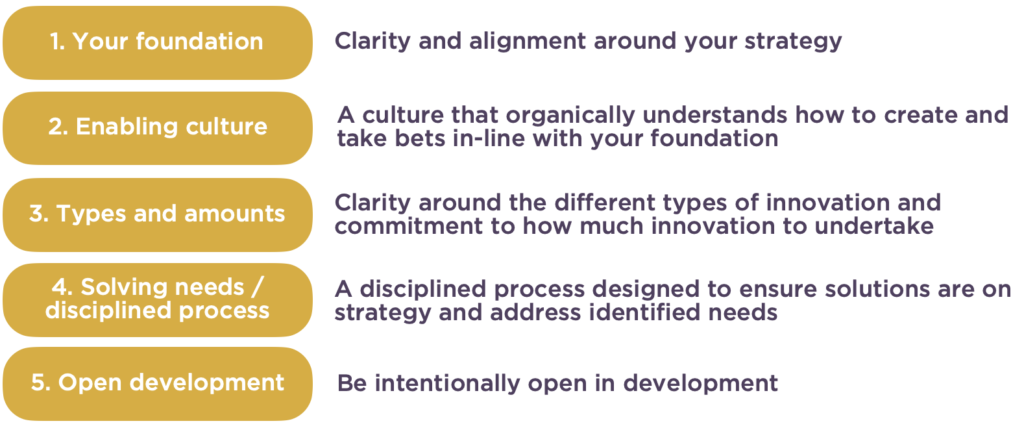Building solutions your market wants and your teams can deliver
My five-year-old daughter likes to say, “You get what you get, and you don’t fuss a bit.”
Which is what I see with growth and innovation. Whatever you are or are not getting today is likely a function of choices you did or did not make yesterday.
So, it’s not surprising that I hear of innovation being challenging and frustrating for many organizations. Common pain points I hear and see include:
- It doesn’t happen organically and takes too much effort
- We seem to bounce from idea to idea, and the work doesn’t connect to our strategy
- We seem only to have work that is iterative and focused on the short-term
- The way the work is done doesn’t seem to match the level of potential return and risk
- Stakeholders don’t have visibility or voice at appropriate moments during discovery, development, or deployment
To change the trajectory and build a sustainable innovation model, these five areas can help:
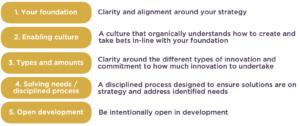
Your foundation
Every day, your organization makes choices about delivering or developing across the customer experience, offering, delivery model, marketing engine, and employee experience.
We can improve the quality of these choices by having a shared context in the form of a strategic foundation. This shared context ensures alignment during development and across different innovation ideas. This alignment improves speed-to-market, reduces waste, and builds equity faster in targeted areas.
This strategic foundation is built around:
- Your defined target and which key buying situations you want to win
- A brand strategy that is easy to think of, relatively different, and meaningful for your target
- An employee value proposition that is cohesive with your brand
- Vision into where your brand could be delivered over time
For brevity, here are thoughts about these areas relative to innovation:
Target and key buying situations
Is there clarity across your organization around whom you want to win with and what key buying situations you want to win for?
While the restaurant category has massive penetration, and many restaurants can draw from across much of that market, you will still want to segment that market and select a target.
Segmenting the market allows you to determine the best areas of opportunity to inform who you choose to target. Your segments and target should be distinct and descriptive. Your target(s) should be big in sheer numbers, spending power, or rate of growth change.
With clarity around your target, you can understand the buying situations your target goes through that might prove to be entry points into the category. Narrow down to those buying situations that are both big and in which you think you can effectively compete.
This clarity—who uses it and when—is the bedrock and will inform almost all aspects of your experience, offering, distribution, pricing, and marketing.
Brand
Your brand is an organizing force. It provides clarity that aids those who develop and those who deliver. Your brand is built for your target and delivers against a pain point or key driver for your key buying situations. Four key areas of brand strategy include:
- Purpose — why you exist
- Promise — your relative differentiator
- Principles — how you deliver your promise
- Presentation — how you express yourself in the marketplace
Employee value proposition
Responsible brand strategists have always incorporated the employee into the brand’s design. It’s even more important now. Ensuring that your promise and principles ring as credible and inspiring to your teams better guarantees the quality of the execution you bring to market.
The brand strategy and employee value propositions need to be cohesive. If not, your employees will sense the disconnect, leading to an erosion of trust and execution.
Distribution
Consumers can get what they want in more ways than ever. If consideration isn’t given to where the brand might be able to be found, it can create limitations down the line that can impede (rate of) growth.
Ideally, this is laid out in a strategic roadmap that identifies the gaps relative to your strategy and what will need to change to close those gaps.
In the event it’s not…
You’ve likely already got a core channel or two. But giving intentional thought to other channels your brand could enter can provide some level of future-proofing. What other distribution channels would allow you to use your equity with your market and their key buying situations? This thinking can be validated through desktop research (sizing of the market, etc.) or concept testing with your audience.
With clarity around where the brand might be able to go over time, sequence this against near, mid-term, and long-term (while I have a point of view on what that means, it’s more vital for it to make sense for your organization). Last, engage the organization around what would have to change across areas like your brand, operational system, sourcing, and talent. Keep this front and center as you build new solutions, and see if you can integrate these elements into your design.
Enabling Culture
Innovation and growth building seem harder than many of the other activities in an organization. Most functions involve the past or knowable areas that are cost-focused. We view them as fixed elements with levers we can pull with exact outcomes (whether that may be true or not).
Growth, on the other hand, involves the future. Despite some excellent tools, it remains somewhat unknowable. It’s often delegated to an area that lacks organizational clout and an understanding of how decisions will impact the company over the short and long term. Critically, the mindset has to be willing to take risks. For this reason, leadership engagement is critical.
If culture is “how we do things around here,” then you must ensure your culture will enable the level of innovation you desire.
Does your company operate in a way that supports and reinforces your foundation:
- Are your values, mindsets, and behaviors aligned with your strategy, and do you have visible assets (symbols, rituals, etc.) that serve as proof points?
- Does your team have the talent and skills to execute against your foundation in determining appropriate bets and how to do them appropriately?
- Does your organization have clarity around roles, processes, systems, and governance in getting the work done?
The type of innovation your company naturally performs today reflects your culture, especially how you set up rewards and penalties.
Ensure the Right Types and Amount of Innovation
Organizations often treat all innovations the same. Yet, not all innovation is the same.
Four broad classifications of innovation can be seen through the lens of return, effort, and risk:
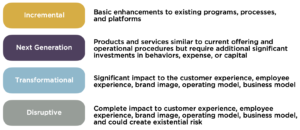
Providing clarity into different classifications of innovation benefits the organization by:
- Ensuring adequate allocations based on strategy and time horizon
- Evaluating the roadmap relative to planned allocations to assess potential risks
- Ensuring planned allocations are appropriately resourced, planned, and budgeted
- Fostering intentional discussion about the ability of the culture to generate an innovation-type
- Developing process appropriate to innovation type
Solving Needs On Strategy with a Disciplined Process
In some form or fashion, the market is meeting its needs today. Understanding how the market is making decisions about solving that need helps frame up potential avenues for how to position your innovation.
This is where your clarity around your target, key buying situations, and brand bear fruit.
Solving Problems and Needs
Start with your target/segment, key buying situation, and brand. With that in place, apply different identified functional, emotional, and social needs onto the map (see illustrative example). You may have done primary or secondary research to identify these.
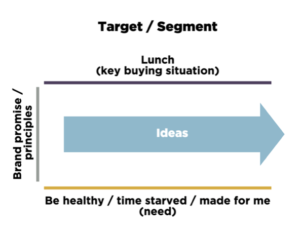
Ideas generated should be on strategy and build equity against your brand and those key buying situations you want to win.
With these ideas in hand, work can begin on building out statements to flesh out the concept further. These concepts are then brought into the market with stimuli similar to how a customer would consider a purchase. These concepts are typically presented with other solutions already in the market to gain an understanding of the potential for the new idea.
There are many different models for how something comes into the market. Regardless of the model, a series of big steps often serve as stages along with some type of gate.
There are two competing forces at this point—iteration and fidelity. Iteration to allow for movement in solution design based on new or different information. Fidelity by continued calibration back against the original concept to minimize drift.
The graphic below shows a process to both allow for iteration and fidelity:
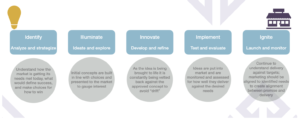
Disciplined Process
While we want innovation to happen organically, we also want the organization to have clarity about how work is supposed to happen. However, deploying the same process for all types of innovation will result in suboptimal results.
Many restaurant companies will want to assess the impact based on return, effort, and risk across six areas:
- Customer experience
- Employee experience
- Brand image
- Sourcing
- Operating model
- Business model
A straight-forward three-point scale can be used, with one being low, two being moderate, and three being high.
One example of this being utilized had incremental ideas in the 15-21 range, next-generation ideas in the 24-30 range, transformational ideas in the 33-42 range, and anything above 43 being disruptive. Each company will want to set their own ranges.
This is not one size fits all
Your assessment of how much impact a given idea will have for your company will, in part, also be a function of how much experience your company has with a given classification type. Further, it is possible that something can score into a given classification, but judgment would suggest it be treated differently.
One would think the level of rigor around the process would increase as one moves from incremental to disruptive. This is true to a degree. Rigor and process have to be deployed at the right times.
Be Intentionally Open in Development
You should be covered between your culture and the governance of your process. But we are building the future and the unknown, which has a tendency to produce a lot of emotion in the organization, especially if the rewards and penalties are not aligned.
Being open provides the organization with two benefits. First, a solution that works better for all stakeholders because of better and more complete input. Second, better speed-to-market over time as trust is established.
Deploying these four principles/techniques in addition to your governance can make your innovation process more open:
Empathize
- Understand each role on the team and honor that point of view to generate the best solution
Collaborate
- Engage appropriate stakeholders as early as possible
- Deploy a core and extended team with appropriate diverse functional representation
- Stakeholders are engaged throughout the process, the scope of involvement will scale
Evaluate
- Engage in regular feedback at the end of the cycle to assess both the delivery of the solution and how the process worked and adjust to become more efficient and effective
Get the core team and structure right
- Growth doesn’t need to be led by one area of the company. It is more about finding talent with the right mindset for the innovation you want to achieve. For example, I have seen incremental innovation successfully led by FP&A and operations functions.
- You can make this approach even more effective by considering the mix of talent you need across your executive sponsor, business owner, and project manager—again, based on the outcomes you are trying to achieve.
- The structure becomes more important in transformational and especially disruptive work. For ideas the organization perceives as riskier, there will be a natural reaction to try and limit that risk. It will do so by eliminating or altering the idea into something more palatable for the company. Which likely leaves it less interesting for other stakeholders.
- This risk can be mitigated by separating the core team from the business while in development or even moving the team into a separate place to limit the amount of “pollution” from the broader organization.
Organizations are not static. Your approach to innovation shouldn’t be either. It requires constant attention and focus.
Rather than “boiling the ocean,” evaluate each of these five areas for its potential return if improved and the effort it would take to work through the change.
Start by focusing on one thing you want to change. As you build success, your ability to deploy the other areas will become easier and easier.

![]()


